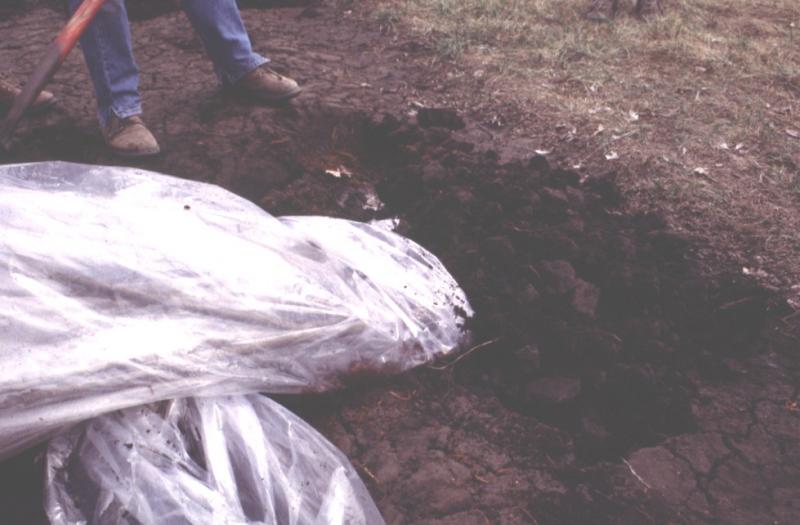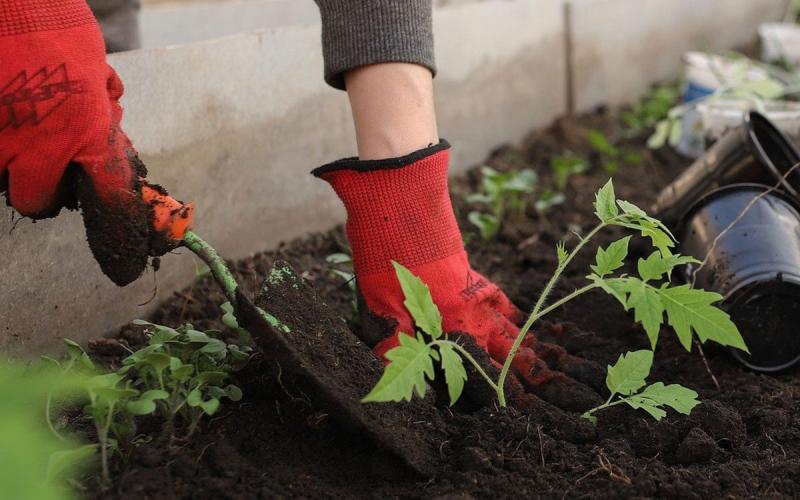Trees are typically planted from stock that is bare-root, container-grown or balled-and-burlapped (B&B). Most trees purchased at garden centers are obtained either as a container-grown tree or B&B while windbreak are generally planted with bare-root trees. Each planting type has their advantages. Containers are common packaging for the smaller size trees, those that are less than 12 feet tall or 1.5 inch caliper (the diameter of the tree 6-inches above the ground) at the time of sale. Containers are easy to transport home and the roots and soil are more protected during this process. Balled-and-burlapped trees are usually larger trees and if a 2 or 3-inch caliper tree is desired most often it will come B&B rather than in a container though larger diameter container trees are becoming more commonly available.
Planting Considerations
Advantages
Bare-root is an excellent means of planting a tree and, while often limited to seedlings to be planted in windbreak, it can also be done successfully in the landscape with even 2- to 3-inch diameter trees. The advantage to planting bare-root is the ease at which the correct planning depth, indicated by placing the highest root just beneath the soil surface, can be determined and avoiding the problems with changes in soil texture between the planting site and the container or B&B ball. Surprising to many, but bare-root trees, properly planted and cared for, can have better survival and growth than either container-grown or B&B trees.
Drawbacks
The primary drawback is the narrow time window in which bare-root trees can be planted. While bare-root trees can be planted in the autumn and spring in most of the United States, in South Dakota only spring planting is advised. Our harsh and dry winters can often injure tender fall planted bare-root trees. Bare-root plantings are limited to the spring time period between soil temperatures warm enough to allow for root growth (at least 45° F) and when the tree’s buds begin to expand. Fortunately trees can be held in cooler to delay bud expansion.
Root Moisture
There are two key consideration when planting bare-root trees: 1) keeping the roots moist until planting and 2) sweating. Bare-root trees are vulnerable to drying out as their roots are exposed to the elements. Bare-root trees must never have the root left to dry and exposed to the sun. This exposure can cause desiccation injury that will result in poor survival and growth. Bare-root trees must be kept cool, about 40° F) until planting and the roots covered with a damp packing material. Ideally the tree would go directly from the packing material into a planting hole that is quickly filled with water and covered but this is always practical. However, the shorter the time between being removed from the packing material and into the planting hole, the better. Even a five minute exposure on a hot, windy day can kill tree roots. If possible hydrate the roots by placing them in a tank of water for one to two hours before planting. Only have the roots covered with water, not the tops. Also do not allow the trees to remain in water for more than two hours, longer time periods may result in root mortality.

Sweating
Some bare-root trees require sweating before being planted. The list of tree species that require sweating is fairly short but bare-root birch, hawthorn, honeylocust, ironwood and oaks all require this treatment. If removed from a cooler and directly planted into the field or landscape, these tree species often fail to break bud and may remain dormant far into the summer and either leaf out very late or not at all. Sweating bare-root trees involves laying the stock down in a shaded area, preferably on the north side of a building or better yet in the building, covering the roots with wet packing material such as straw or fine woodchips and then sealing the entire plant, tops and roots, with a sheet of clear plastic that is held tight to the ground. The daytime air temperature should be between 50° and 60° F. Once the sweating process has started, the buds on the trees in this “mini sauna” will begin to swell within a few days due to the moderate temperatures and high humidity. Once the buds begin to swell remove the trees and plant them. This is the next problem; the trees must be planted immediately following sweating but if planted in dry, cool conditions, the expanding buds will continue to open very slowly, if at all. The sweated trees should be planted in humid, warm conditions and these conditions may not occur in South Dakota until mid-May. Therefore, keep bare-root oak and other species that require sweating in the cooler until early May, and then sweat them for a week. By then the conditions outside should be acceptable for planting these bare-root trees in the field.


